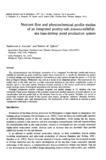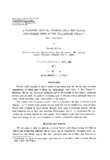Shrimp farming in the Asia-Pacific: environment and trade issues and regional cooperation
- Global styles
- MLA
- Vancouver
- Elsevier - Harvard
- APA
- Help

Download URL
oldsite.nautilus.orgDate
1995Author
Page views
3,220ASFA keyword
AGROVOC keyword
Metadata
Show full item record
Share
Abstract
Production of farmed shrimp has grown at the phenomenal rate of 20-30% per year in the last two decades. The leading shrimp producers are in the Asia-Pacific region while the major markets are in Japan, the U.S.A. and Europe. The dramatic failures of shrimp farms in Taiwan, Thailand, Indonesia and China within the last five years have raised concerns about the sustainability of shrimp aquaculture, in particular intensive farming. After a brief background on shrimp farming, this paper reviews its environmental impacts and recommends measures that can be undertaken on the farm, country and regional levels to promote long-term sustainability of the industry. Among the environmental effects of shrimp culture are the loss of mangrove goods and services as a result of conversion, salinization of soil and water, discharge of effluents resulting in pollution of the pond system itself and receiving waters, and overuse or misuse of chemicals. Recommendations include the protection and restoration of mangrove habitats and wild shrimp stocks, management of pond effluents, regulation of chemical use and species introductions, and an integrated coastal area management approach. Regional cooperation is needed in research and information sharing, and trade in supplies and equipment.
The contribution of farming to global shrimp production has dramatically risen from a mere 6% in 1970 to 26% in 1990 (FAO, 1993). In terms of value, this has meant a 16-fold increase from US$300 million in 1980 to $7 billion worth of cultured shrimp by 1993 (Rosenberry, 1993). Annual growth rate of farmed shrimp has been 20-30% in the last 20 years (Table 1). In contrast, increases in commercial landings of shrimp have stabilized at 2-3% yearly due to the full or close to full exploitation of most wild stocks and high fuel costs. However, the recent failures of shrimp crops in Taiwan followed by China and Indonesia have raised concerns about the sustainability of shrimp aquaculture. This paper will a) give a background of the shrimp farming industry, b) review the different shrimp culture systems, c) evaluate the environmental impacts of shrimp farming, and d) recommend actions to promote long-term sustainability in the industry including suggestions for regional cooperation.
Type
Conference paperCollections
- Conference Proceedings [298]
Related items
Showing items related by title, author, creator and subject.
-
Asian shrimp situation
Carreon-Lagoc, Julia; Southeast Asian Fisheries Development Center, Aquaculture Department (Aquaculture Department, Southeast Asian Fisheries Development Center, 1990) -
Nutrient flow and physicochemical profile studies of an integrated poultry-salt-Artemia-milkfish-sea bass-shrimp pond production system
Jumalon, Nepheronia A.; Ogburn, Damian M. (Wetteren, Belgium: Universal Press, 1987)The physicochemical and biological parameters of an integrated flow-through poultry-salt-Artemia-milkfish-sea bass-shrimp pond production system were monitored for 6 months to determine the pattern of nutrient changes and ... -
A further note to “fishing gear for prawn and shrimp used in the Philippines today”
Motoh, Hiroshi (Carcinological Society of Japan, 1983)Motoh (1980) reported 9 and 13 kinds of shrimping gear for the fry and the adult respectively, of which most of them are indigenously used today in the Philippines. Howerver, druing the continued ecological survey of ...





